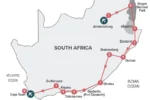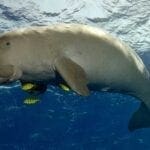Eswatini is a country of magnificent natural beauty and rich history. The country’s name changed from Swaziland in April 2018 and the new name means ‘land of the Swazi’s’.
The Kingdom of Eswatini is a small landlocked country, surrounded by South Africa except for a short border with Mozambique. Mbabane is the capital of Eswatini and is in the Hhohho region. The official currency of Eswatini is the Lilangeni (plural is Emalangeni) which is equivalent to the South African Rand.
Tourism is starting to increase and as this happens; so do the facilities on offer. The natural drawcards are there. So if you are looking for an off-the-beaten-track adventure; Eswatini is an excellent place to go. It offers Big 5 game safaris, natural beauty activities such as; hiking, bird watching, cultural tours and so much more.
This laid back and breathtakingly beautiful country is one of the world’s few remaining absolute monarchies.
The most celebrated cultural event in Eswatini is the annual reed dance. This 3-day event usually takes place around August when the Umhlanga reed has matured and the weather is less harsh. It culminates in a traditional dance performed in front of the king; by up to thirty thousand Swazi maidens in a public arena. This is an ancient custom, and the King is free to choose one of the maidens for his bride. This has sparked some debate around the world, but for the vast majority of Swazis; it is an honor and a privilege.
Birding
Eswatini is home to 52 southern African endemics and is one of the only breeding sites for the blue swallow; one of Africa’s rarest breeding birds. Other A-listers for keen birders include the Narina trogon, southern bald ibis, pink-throated twinspot, and crowned eagle. For non-birders the most popular is the purple-crested turaco. The royal national emblem and a very pretty bird.
Eswatini has become quite renowned for its arts and crafts and 2 of these; in particular, are Swazi Candles and Ngwenya Glass.
Swazi Candles
Swazi Candles is in the Malkerns Valley and has been producing fine handmade candles since 1981.
Artists and craftsmen produce unique candle designs using the age-old technique of ‘millefiore’; a technique originally used to produce glass. However; instead of glass; the gifted candle makers of Eswatini use a special hard wax to create their colorful designs. The hard wax veneer forms the outer shell of the candle, which hardly melts when the candle is lit. This creates a rich, romantic glow as the candle burns deeper into the container lighting up the casing. Once the original inside wax is gone; the shells can still be used when refitted with a votive or tea candle.
Ngwenya Glass Village
Recycled glass is used to hand-make beautiful sculptures; from African animals, birds, fish, large vases, and wine coolers to tableware and simple paperweights at Ngwenya Glass Village.
Main Attractions in Eswatini
Mlilwane Wildlife Sanctuary
Eswatini’s most frequently visited reserve and pioneer conservation area is Mlilwane Wildlife Sanctuary; where one can enjoy the beauty of the surroundings and the abundant wildlife that grace the plains. Visitors can explore the southern portion of the Sanctuary by foot, vehicle, on horseback, and on mountain bikes.
This beautiful, secluded sanctuary is in the Ezulwini Valley, in between Mbabane and Manzini. With 24-hour access to the Sanctuary, guests are free to enjoy the neighboring tourist hubs of Ezulwini and Malkerns; with their many unique attractions and craft shops. From the western boundary, the huge Usutu Forest provides a dramatic backdrop stretching into the distant hills.
The Sanctuary covers 4,560 hectares and comprises a southern and northern section. The southern section is predominately open grassland plains with middle veld vegetation, stretching up onto the striking Nyonyane Mountain; with its exposed granite peak known as the “Rock of Execution”. Behind these mountains, the stunning Mantenga waterfall and beautiful Usushwana Valley form the divide; before stretching up to the northern section, which includes one of the highest surrounding points at Luphohlo. Tourist activities are concentrated in the southern section; while guided trails explore the northern section.
Hlane Royal National Park
Hlane Royal National Park in eSwatini is home to lions, elephants, and white rhino; with abundant and diverse birdlife, including the highest density of nesting white-backed vultures in Africa.
eSwatini’s largest protected area, Hlane Royal National Park, is home to the largest herds of game in the Kingdom. Hlane also hosts 4 of the big 5; Lions, Elephants, Rhino, and Leopard. The only park within Eswatini where you will get to see them all! For the bird and nature enthusiasts, Hlane hosts the southernmost nesting site of the marabou stork; a sight in itself to behold.
A network of self-drive game-viewing roads crisscrosses the park’s flat terrain; weaving between the hardwood vegetation and shallow pans that attract great herds of animals especially in the dry winter months. Guided walking safaris, mountain biking, and game drives in Hlane’s open safari vehicles are also available.
Mkhaya Refuge for Endangered Species
In the southeast of Eswatini, lies an unspoiled wilderness; Mkhaya Refuge for Endangered Species.
For the animals that once roamed wild and free, uninhibited by fences and boundaries; they faced and still face an uncertain future. It became clear to the Reilly Family, Eswatini’s foremost nature conservationists; that these animals needed a place of refuge and tranquility. Therefore; in 1979 Mkhaya became a Nature Reserve. Its focus has expanded over the years to include endangered species such as black rhino, roan & sable antelope, tsessebe, white rhino, elephant, and other locally endangered species.
Mkhaya Game Reserve comprises acacia-dominated thornveld in the south and broadleaf sand veld in the north. Unique, intimate encounters with Mkhaya’s wildlife are almost guaranteed; as all travel within the reserve is solely by Big Game Parks’ open safari vehicles or on foot (all guided).
Staffed and patrolled entirely by Swazis from neighboring communities; Mkhaya currently boasts what is arguably Africa’s most effective anti-poaching unit. Mkhaya is totally self-financing through visitor revenues.
Climate and Best Time to Visit Eswatini
As with all Southern Hemisphere countries, seasons are opposite to that of the majority of Europe and North America in the Northern Hemisphere. Generally speaking, rain falls mostly during the summer months; often in the form of thunderstorms typical of tropical environments, although Eswatini can vary from tropical to temperate.
The dry season (Winter) lasts from mid-April to mid-October, with an average temperature of 20°C (the days being sunny and the nights chilly). The rainy season begins at the end of October, lasting through to March. During the dry seasons expect hot days when the sun is out, but temperatures can drop quickly at night with extra layers needed all year round. Temperature variations are also dependent on the altitude of the different regions.
Eswatini Accommodation
A wide range of accommodation can be found in Eswatini. For now, we haven’t added any to our website but may do so in future. However, we are able to offer you any accommodations you like so let us know what you have in mind.
Eswatini Tours
Most tours that visit Eswatini will incorporate South Africa so it is great if you want to get that extra immigration stamp in your passport!



















